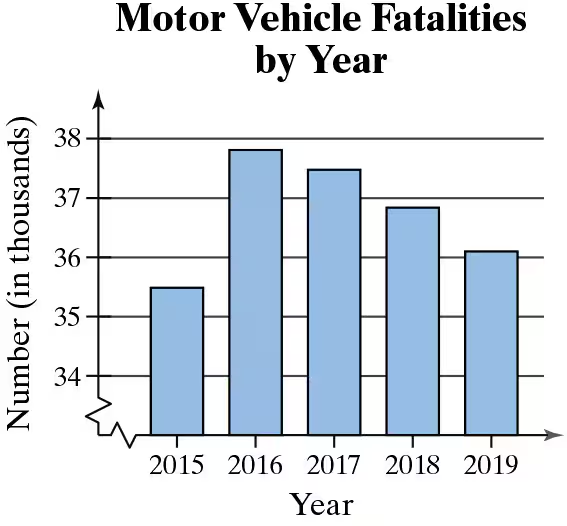Table of contents
- 1. Intro to Stats and Collecting Data55m
- 2. Describing Data with Tables and Graphs1h 55m
- 3. Describing Data Numerically1h 45m
- 4. Probability2h 16m
- 5. Binomial Distribution & Discrete Random Variables2h 33m
- 6. Normal Distribution and Continuous Random Variables1h 38m
- 7. Sampling Distributions & Confidence Intervals: Mean1h 3m
- 8. Sampling Distributions & Confidence Intervals: Proportion1h 12m
- 9. Hypothesis Testing for One Sample1h 1m
- 10. Hypothesis Testing for Two Samples2h 8m
- 11. Correlation48m
- 12. Regression1h 4m
- 13. Chi-Square Tests & Goodness of Fit1h 20m
- 14. ANOVA1h 0m
1. Intro to Stats and Collecting Data
Intro to Stats
Problem 1.2.24
Textbook Question
Determine the level of measurement of the data listed on the horizontal and vertical axes in the figure.

 Verified step by step guidance
Verified step by step guidance1
Step 1: Understand the concept of levels of measurement. There are four levels of measurement in statistics: nominal, ordinal, interval, and ratio. Each level determines the type of data and the mathematical operations that can be performed.
Step 2: Analyze the horizontal axis (Year). The years (2015, 2016, 2017, 2018, 2019) represent a sequential order but do not have a true zero point or equal intervals between values. This makes the data on the horizontal axis an interval level of measurement.
Step 3: Analyze the vertical axis (Number of fatalities in thousands). The numbers represent a quantitative measure with a true zero point (zero fatalities is meaningful) and equal intervals between values. This makes the data on the vertical axis a ratio level of measurement.
Step 4: Confirm the interpretation of the graph. The horizontal axis (Year) is interval data because it represents time, which is sequential but lacks a true zero. The vertical axis (Number of fatalities) is ratio data because it is a countable quantity with a meaningful zero and equal intervals.
Step 5: Summarize the findings. The horizontal axis (Year) is measured at the interval level, and the vertical axis (Number of fatalities) is measured at the ratio level.
 Verified video answer for a similar problem:
Verified video answer for a similar problem:This video solution was recommended by our tutors as helpful for the problem above
Video duration:
6mPlay a video:
Was this helpful?
Key Concepts
Here are the essential concepts you must grasp in order to answer the question correctly.
Levels of Measurement
Levels of measurement refer to the different ways data can be categorized and quantified. The four primary levels are nominal, ordinal, interval, and ratio. Each level has specific characteristics that determine how data can be analyzed and interpreted. Understanding these levels is crucial for selecting appropriate statistical methods and accurately interpreting results.
Recommended video:
Guided course

Difference in Proportions: Hypothesis Tests Example 1
Bar Graphs
Bar graphs are visual representations of categorical data, where each category is represented by a bar whose length corresponds to the value it represents. In this case, the horizontal axis represents years, while the vertical axis shows the number of fatalities in thousands. Bar graphs are useful for comparing quantities across different categories and can help identify trends over time.
Recommended video:

Creating Bar Graphs and Pareto Charts
Descriptive Statistics
Descriptive statistics summarize and describe the main features of a dataset. This includes measures such as mean, median, mode, and range, which provide insights into the central tendency and variability of the data. In the context of the bar graph, descriptive statistics can help analyze trends in motor vehicle fatalities over the years, allowing for a clearer understanding of the data presented.
Recommended video:
Guided course

Parameters vs. Statistics

 2:13m
2:13mWatch next
Master Introduction to Statistics Channel with a bite sized video explanation from Patrick
Start learning

